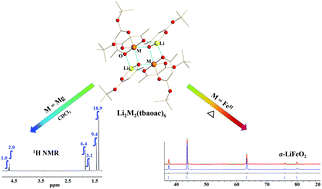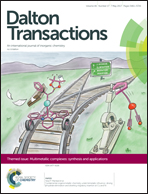Heterometallic molecular precursors for a lithium–iron oxide material: synthesis, solid state structure, solution and gas-phase behaviour, and thermal decomposition†
Abstract
Three heterometallic single-source precursors with a Li : Fe = 1 : 1 ratio for a LiFeO2 oxide material are reported. Heterometallic compounds LiFeL3 (L = tbaoac (1), ptac (2), and acac(3)) have been obtained on a large scale, in nearly quantitative yields by one-step reactions that employ readily available reagents. The heterometallic precursor LiFe(acac)3 (3) with small, symmetric substituents on the ligand (acac = pentane-2,4-dionate), maintains a 1D polymeric structure in the solid state that limits its volatility and prevents solubility in non-coordinating solvents. The application of the unsymmetrical ligands, tbaoac (tert-butyl acetoacetate) and ptac (1,1,1-trifluoro-5,5-dimethyl-2,4-hexanedionate), that exhibit different bridging properties at the two ends of the ligand, allowed us to change the connectivity pattern within the heterometallic assembly. The latter was demonstrated by structural characterization of heterometallic complexes LiFe(tbaoac)3 (1) and LiFe(ptac)3 (2) that consist of discrete heterocyclic tetranuclear molecules Li2Fe2L6. The compounds are highly volatile and exhibit a congruent sublimation character. DART mass spectrometric investigation revealed the presence of heterometallic molecules in the gas phase. The positive mode spectra are dominated by the presence of [M − L]+ peaks (M = Li2Fe2L6). In accord with their discrete molecular structure, complexes 1 and 2 are highly soluble in nearly all common solvents. In order to test the retention of the heterometallic structure in solution, the diamagnetic analog of 1, LiMg(tbaoac)3 (4), has been isolated. Its tetranuclear molecular structure was found to be isomorphous to that of the iron counterpart. 1H and 7Li NMR spectroscopy unambiguously confirmed the presence of heterometallic molecules in solutions of non-coordinating solvents. The heterometallic precursor 1 was shown to exhibit clean thermal decomposition in air that results in phase-pure α-modification of layered oxide LiFeO2, the prospective cathode material for lithium ion batteries.

- This article is part of the themed collection: Multimetallic complexes: synthesis and applications


 Please wait while we load your content...
Please wait while we load your content...